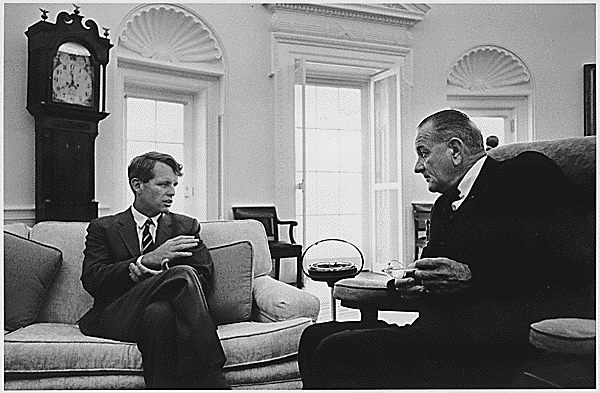“Soft Pressure” by “Wassily Kandinsky” (1931)
Monthly Archives: March 2013
The Ones You Can Depend On
Over at the New York Review of Books here’s Gary Wills on Robert Caro’s The Passage of Power:
Robert Caro’s epic biography of Lyndon Johnson—this is the fourth volume of a planned five—was originally conceived and has been largely executed as a study of power. But this volume has been overtaken by a more pressing theme. It is a study in hate. The book’s impressive architectonics come from the way everything is structured around two poles or pillars—Lyndon Johnson and Robert Kennedy, radiating reciprocal hostilities at every step of the story. Caro calls it “perhaps the greatest blood feud of American politics in the twentieth century.” With some reservations about the word “blood,” one has to concede that Caro makes good his claim for this dynamic in the tale he has to tell.
There are many dramatic events, throughout the volume, that illustrate Caro’s theme. I begin with one that could seem insignificant to those not knowing the background on both sides, because it shows that even the slightest brush between these two triggered rancorous inner explosions. Johnson, newly sworn in as president, had just come back to Washington on Air Force One from the terrible death of John Kennedy in Dallas. Robert Kennedy sped up the steps to the plane and rushed fiercely down the length of the cabin through everyone standing in his way (including the new president) to reach Jacqueline Kennedy. Understandable that he would first of all want to comfort the widow? Yes, but. This was the first of many ways Bobby (called that throughout) tried in the first days to ignore the man who had ignominiously, in his eyes, supplanted his brother by a murder in the man’s own Texas.
Caro understands that Bobby was determined not to see Johnson, even if he saw him—so he did not see him. But Johnson saw him not seeing, and hated him the more. That is how hate narrows one—narrows what one wants to see, or is able to see, in order to keep one’s hatred tended and hard.
Nobody Does it Better
…than Chad Jennings.
The latest notes from spring training: here, here, and here.
[Drawings by Robert Weaver]
Fail Better
Via Kottke, here’s the annotated wit and wisdom of Louis C. K. over at Splitsider.
“Bill Cosby, George Carlin and Richard Pryor are my favorite stand-ups.”
I’m with him there.
[Photo Credit: Chris Buck]
Back to Basics
Dimelo, a Banter regular, pointed out this article on Dr. James Andrews by Dennis Manoloff in the Cleveland Plain Dealer.
PD: The best advice you would give parents of a young athlete?
J.A.: The first thing I would tell them is, their kid needs at least two months off each year to recover from a specific sport. Preferably, three to four months. Example: youth baseball. For at least two months, preferably three to four months, they don’t need to do any kind of overhead throwing, any kind of overhead sport, and let the body recover in order to avoid overuse situations. That’s why we’re seeing so many Tommy John procedures, which is an adult operation designed for professionals. In my practice now, 30 to 40 percent of the ones I’m doing are on high-schoolers, even down to ages 12 or 13. They’re already coming in with torn ligaments.
Give them time off to recover. Please. Give them time to recover.
PD: What are your thoughts on youngsters throwing curveballs?
J.A.: Throwing a curveball has a neuromuscular-control dynamic. In other words, it takes a lot of natural ability at a young age to throw that pitch. It’s a complicated pitch. If you throw it with good mechanics, it doesn’t have any greater force on your shoulder than throwing other pitches, but you’ve got to throw it correctly. It’s misleading to say it’s OK to throw the curveball with good mechanics because the rub is, most kids don’t throw it with good mechanics. My rule of thumb is, don’t throw the curveball until you can shave, until your bone structure has matured and you have the neuromuscular control to be able to throw the pitch properly.
PD: What advice would you give pitchers, in general?
J.A.: 1. Use proper mechanics. The No. 1 problem in any specific sport is improper mechanics.
2. Don’t play year-round.
3. Avoid the radar gun at a young age. Don’t try to overthrow. A lot of kids are 13 years old and checking the radar gun. That’s going to get you in trouble. The radar gun makes you want to throw harder than you are capable of throwing.
4. Be very careful with showcases. I call them “show-off” cases because kids go there Saturday after throwing the football on Friday. They jump on a mound and overthrow because scouts are there. The next thing you know, the shoulder or elbow gets injured.
Andrew’s new book, Any Given Monday, is out now.
The Big Lug, Take Two
I’m looking forward to seeing if Michael Pineda gives the Yanks anything this year. Whadda ya think?
--Earl Weaver























